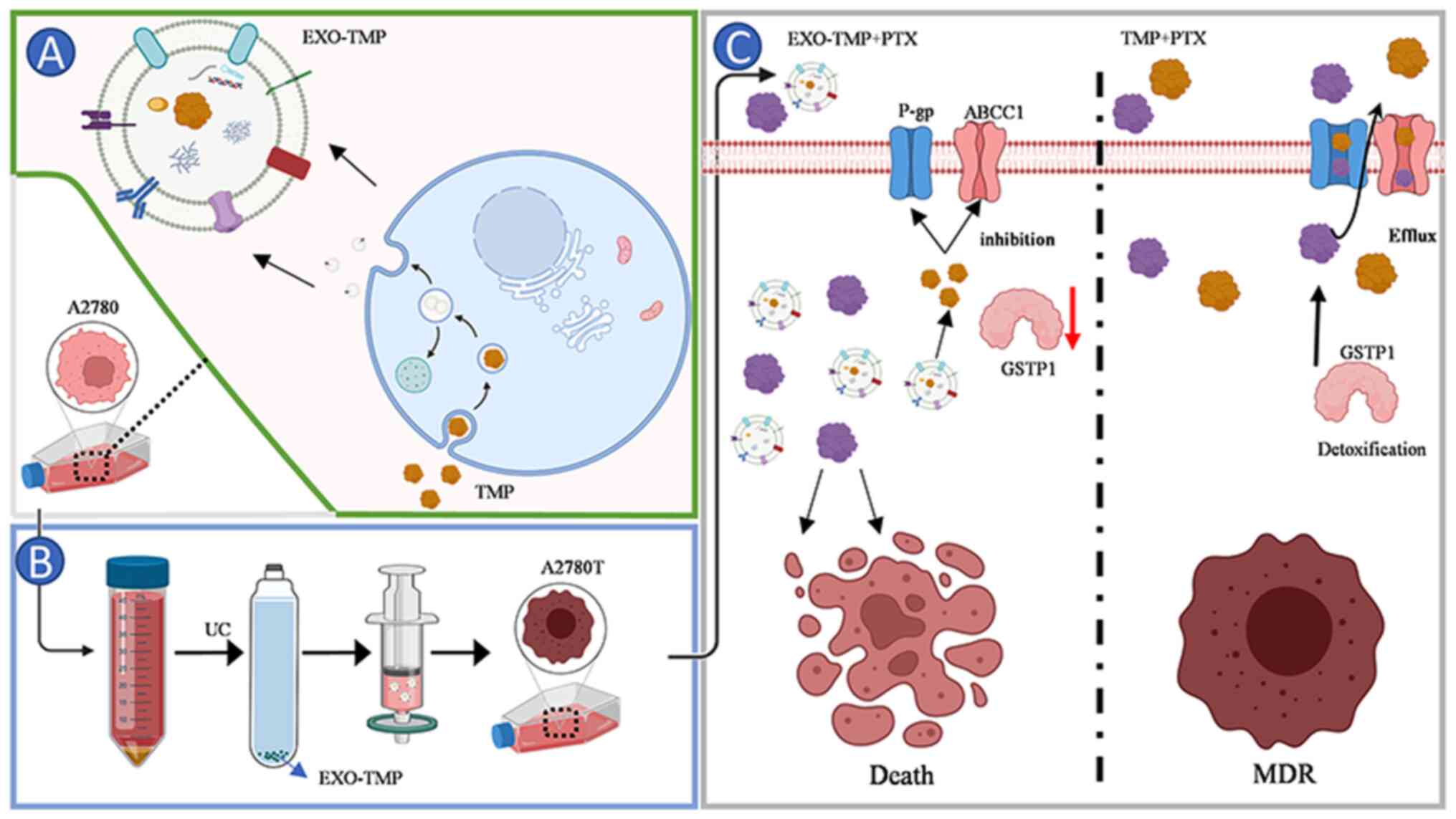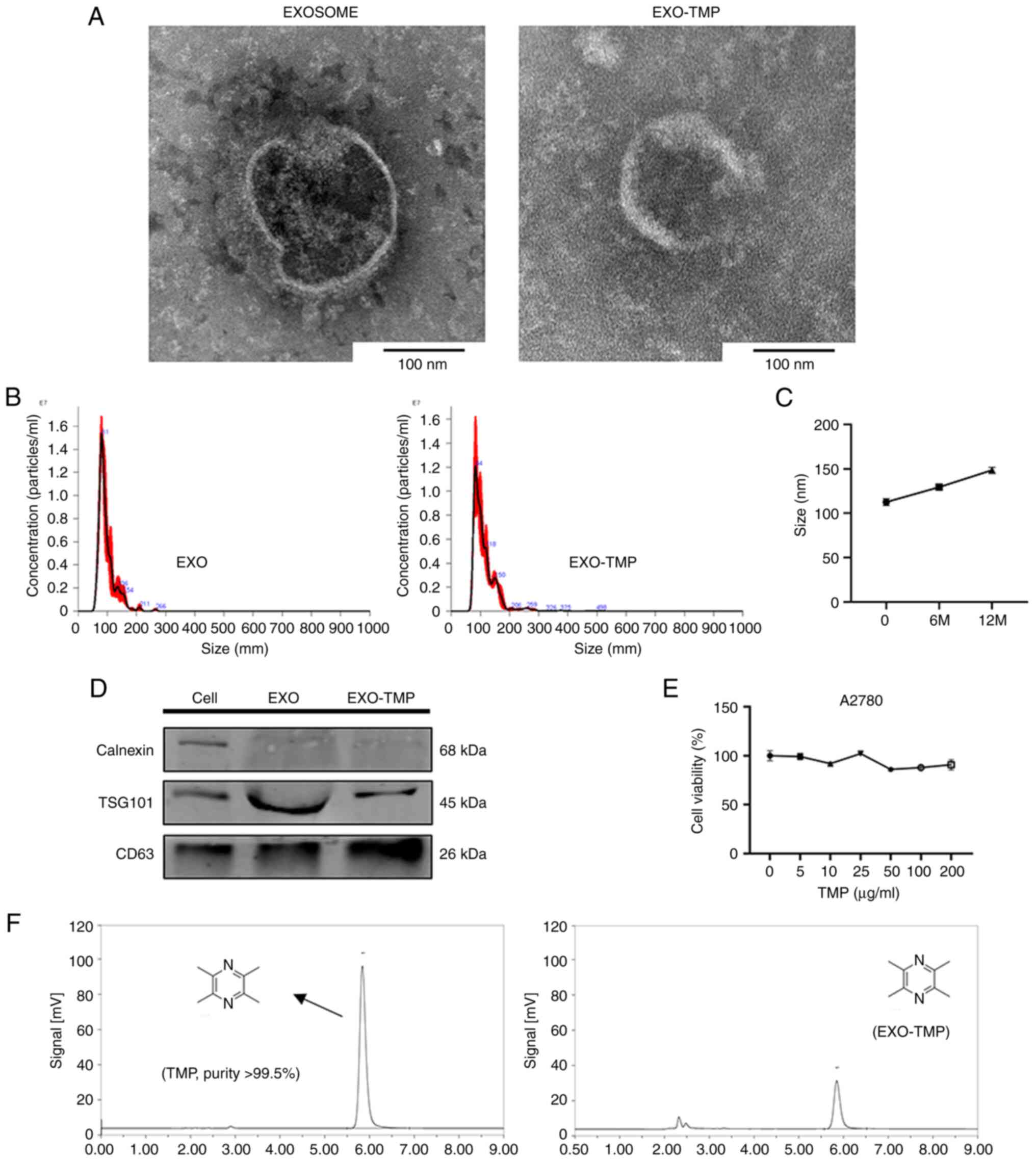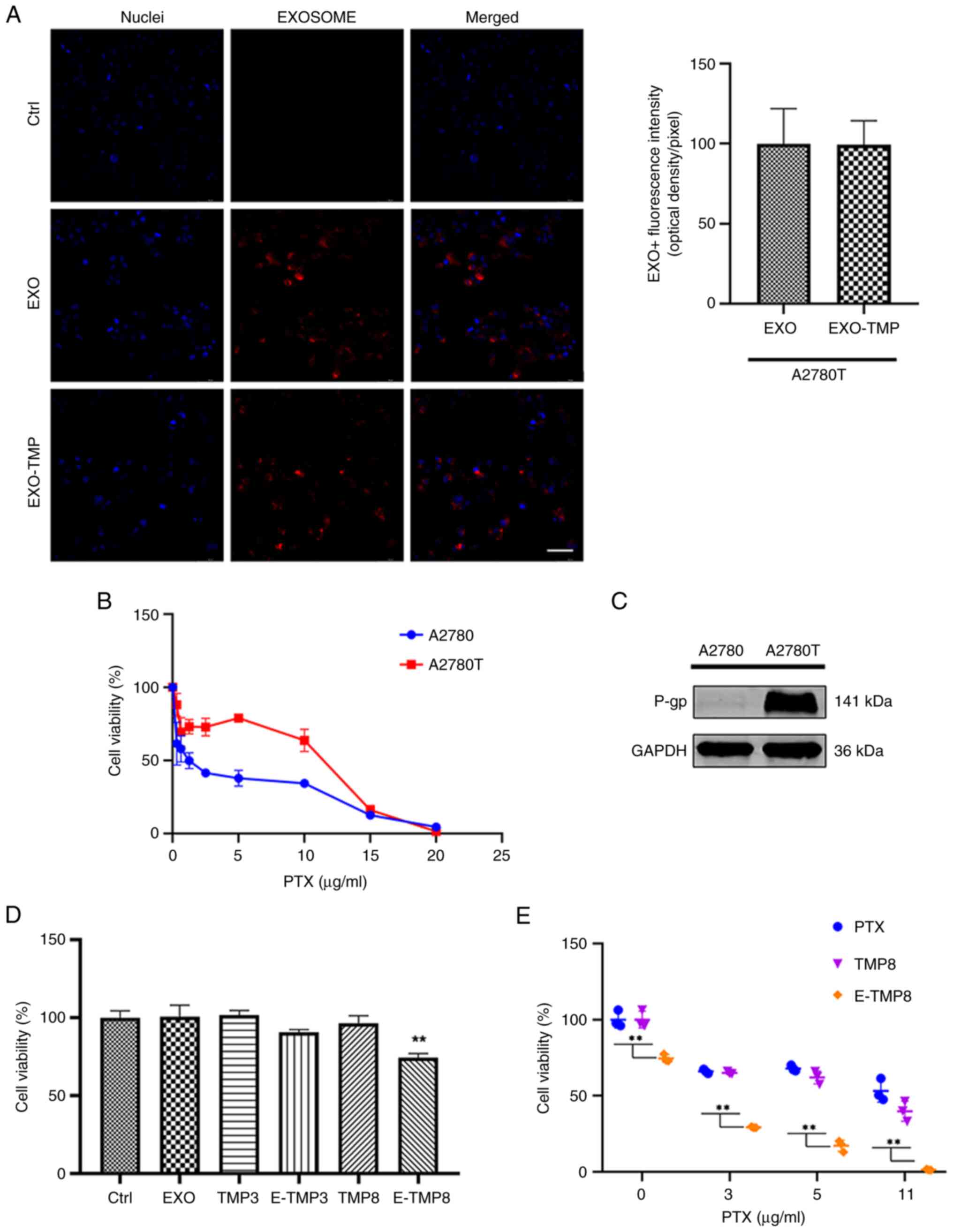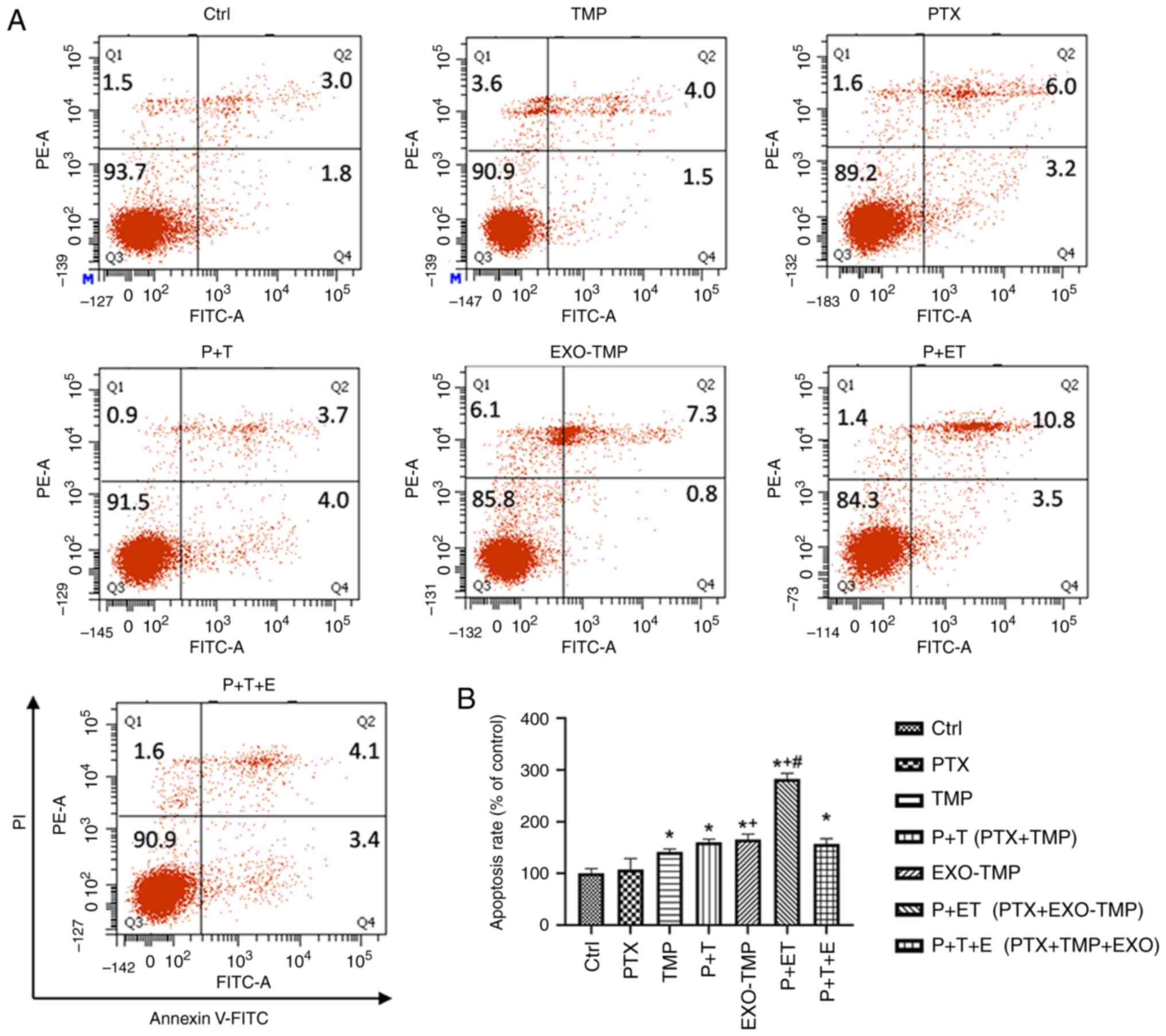|
1
|
Miller KD, Nogueira L, Mariotto AB,
Rowland JH, Yabroff KR, Alfano CM, Jemal A, Kramer JL and Siegel
RL: Cancer treatment and survivorship statistics, 2019. CA Cancer J
Clin. 69:363–385. 2019. View Article : Google Scholar : PubMed/NCBI
|
|
2
|
Bodurka-Bevers D, Sun CC and Gershenson
DM: Pharmacoeconomic considerations in treating ovarian cancer.
Pharmacoeconomics. 17:133–150. 2000. View Article : Google Scholar : PubMed/NCBI
|
|
3
|
Yang ZJ, Zhao BB and Li L: The
significance of the change pattern of serum CA125 level for judging
prognosis and diagnosing recurrences of epithelial ovarian cancer.
J Ovarian Res. 9:572016. View Article : Google Scholar : PubMed/NCBI
|
|
4
|
Xiao R, You L, Zhang L, Guo X, Guo E, Zhao
F, Yang B, Li X, Fu Y, Lu F, et al: Inhibiting the IRE1α axis of
the unfolded protein response enhances the antitumor effect of
AZD1775 in TP53 mutant ovarian cancer. Adv Sci (Weinh).
9:e21054692022. View Article : Google Scholar : PubMed/NCBI
|
|
5
|
Miller EM, Samec TM and Alexander-Bryant
AA: Nanoparticle delivery systems to combat drug resistance in
ovarian cancer. Nanomedicine. 31:1023092021. View Article : Google Scholar : PubMed/NCBI
|
|
6
|
Chiappa M, Guffanti F, Bertoni F, Colombo
I and Damia G: Overcoming PARPi resistance: Preclinical and
clinical evidence in ovarian cancer. Drug Resist Updat.
55:1007442021. View Article : Google Scholar : PubMed/NCBI
|
|
7
|
Norouzi-Barough L, Sarookhani MR, Sharifi
M, Moghbelinejad S, Jangjoo S and Salehi R: Molecular mechanisms of
drug resistance in ovarian cancer. J Cell Physiol. 233:4546–4562.
2018. View Article : Google Scholar : PubMed/NCBI
|
|
8
|
Eisenhauer EA: Real-world evidence in the
treatment of ovarian cancer. Ann Oncol. 28 (Suppl 8):viii61–viii65.
2017. View Article : Google Scholar : PubMed/NCBI
|
|
9
|
Huang MY, Zhang LL, Ding J and Lu JJ:
Anticancer drug discovery from Chinese medicinal herbs. Chin Med.
13:352018. View Article : Google Scholar : PubMed/NCBI
|
|
10
|
Wang X, Liu Z, Sui X, Wu Q, Wang J and Xu
C: Elemene injection as adjunctive treatment to platinum-based
chemotherapy in patients with stage III/IV non-small cell lung
cancer: A meta-analysis following the PRISMA guidelines.
Phytomedicine. 59:1527872019. View Article : Google Scholar : PubMed/NCBI
|
|
11
|
Zhang E, Shi H, Yang L, Wu X and Wang Z:
Ginsenoside Rd regulates the Akt/mTOR/p70S6K signaling cascade and
suppresses angiogenesis and breast tumor growth. Oncol Rep.
38:359–367. 2017. View Article : Google Scholar : PubMed/NCBI
|
|
12
|
Malyutina A, Majumder MM, Wang W, Pessia
A, Heckman CA and Tang J: Drug combination sensitivity scoring
facilitates the discovery of synergistic and efficacious drug
combinations in cancer. PLoS Comput Biol. 15:e10067522019.
View Article : Google Scholar : PubMed/NCBI
|
|
13
|
Guo SK, Chen KJ, Qian ZH, Weng WL and Qian
MY: Tetramethylpyrazine in the treatment of cardiovascular and
cerebrovascular diseases. Planta Med. 47:891983. View Article : Google Scholar : PubMed/NCBI
|
|
14
|
Chen Z, Zhang C, Gao F, Fu Q, Fu C, He Y
and Zhang J: A systematic review on the rhizome of Ligusticum
chuanxiong Hort. (Chuanxiong). Food Chem Toxicol. 119:309–325.
2018. View Article : Google Scholar : PubMed/NCBI
|
|
15
|
Zhao Y, Liu Y and Chen K: Mechanisms and
clinical application of tetramethylpyrazine (an interesting natural
compound isolated from Ligusticum Wallichii): Current status
and perspective. Oxid Med Cell Longev. 2016:21246382016. View Article : Google Scholar : PubMed/NCBI
|
|
16
|
Wang S, Lei T and Zhang M: The reversal
effect and its mechanisms of tetramethylpyrazine on multidrug
resistance in human bladder cancer. PLoS One. 11:e01577592016.
View Article : Google Scholar : PubMed/NCBI
|
|
17
|
Wang XB, Wang SS, Zhang QF, Liu M, Li HL,
Liu Y, Wang JN, Zheng F, Guo LY and Xiang JZ: Inhibition of
tetramethylpyrazine on P-gp, MRP2, MRP3 and MRP5 in multidrug
resistant human hepatocellular carcinoma cells. Oncol Rep.
23:211–215. 2010.PubMed/NCBI
|
|
18
|
Zhou X, Wang A, Wang L, Yin J, Wang L, Di
L, Hoi MP, Shan L, Wu X and Wang Y: A danshensu-tetramethylpyrazine
conjugate DT-010 overcomes multidrug resistance in human breast
cancer. Front Pharmacol. 10:7222019. View Article : Google Scholar : PubMed/NCBI
|
|
19
|
Huang HH, Liu FB, Ruan Z, Zheng J, Su YJ
and Wang J: Tetramethylpyrazine (TMPZ) triggers S-phase arrest and
mitochondria-dependent apoptosis in lung cancer cells. Neoplasma.
65:367–375. 2018. View Article : Google Scholar : PubMed/NCBI
|
|
20
|
Alotaibi BS, Buabeid M, Ibrahim NA,
Kharaba ZJ, Ijaz M, Noreen S and Murtaza G: Potential of
nanocarrier-based drug delivery systems for brain targeting: A
current review of literature. Int J Nanomedicine. 16:7517–7533.
2021. View Article : Google Scholar : PubMed/NCBI
|
|
21
|
Kalluri R and LeBleu VS: The biology,
function, and biomedical applications of exosomes. Science.
367:eaau69772020. View Article : Google Scholar : PubMed/NCBI
|
|
22
|
Antimisiaris SG, Mourtas S and Marazioti
A: Exosomes and exosome-inspired vesicles for targeted drug
delivery. Pharmaceutics. 10:2182018. View Article : Google Scholar : PubMed/NCBI
|
|
23
|
Kim MS, Haney MJ, Zhao Y, Mahajan V,
Deygen I, Klyachko NL, Inskoe E, Piroyan A, Sokolsky M, Okolie O,
et al: Development of exosome-encapsulated paclitaxel to overcome
MDR in cancer cells. Nanomedicine. 12:655–664. 2016. View Article : Google Scholar : PubMed/NCBI
|
|
24
|
Elsharkasy OM, Nordin JZ, Hagey DW, de
Jong OG, Schiffelers RM, Andaloussi SE and Vader P: Extracellular
vesicles as drug delivery systems: Why and how? Adv Drug Deliv Rev.
159:332–343. 2020. View Article : Google Scholar : PubMed/NCBI
|
|
25
|
Chinnappan M, Srivastava A, Amreddy N,
Razaq M, Pareek V, Ahmed R, Mehta M, Peterson JE, Munshi A and
Ramesh R: Exosomes as drug delivery vehicle and contributor of
resistance to anticancer drugs. Cancer Lett. 486:18–28. 2020.
View Article : Google Scholar : PubMed/NCBI
|
|
26
|
Ma J, Zhang Y, Tang K, Zhang H, Yin X, Li
Y, Xu P, Sun Y, Ma R, Ji T, et al: Reversing drug resistance of
soft tumor-repopulating cells by tumor cell-derived
chemotherapeutic microparticles. Cell Res. 26:713–727. 2016.
View Article : Google Scholar : PubMed/NCBI
|
|
27
|
Gao Y, Zhang H, Zhou N, Xu P, Wang J, Gao
Y, Jin X, Liang X, Lv J, Zhang Y, et al: Methotrexate-loaded
tumour-cell-derived microvesicles can relieve biliary obstruction
in patients with extrahepatic cholangiocarcinoma. Nat Biomed Eng.
4:743–753. 2020. View Article : Google Scholar : PubMed/NCBI
|
|
28
|
Rao Q, Zuo B, Lu Z, Gao X, You A, Wu C, Du
Z and Yin H: Tumor-derived exosomes elicit tumor suppression in
murine hepatocellular carcinoma models and humans in vitro.
Hepatology. 64:456–472. 2016. View Article : Google Scholar : PubMed/NCBI
|
|
29
|
Yong T, Zhang X, Bie N, Zhang H, Zhang X,
Li F, Hakeem A, Hu J, Gan L, Santos HA and Yang X: Tumor
exosome-based nanoparticles are efficient drug carriers for
chemotherapy. Nat Commun. 10:38382019. View Article : Google Scholar : PubMed/NCBI
|
|
30
|
Yu Z, Tang H, Chen S, Xie Y, Shi L, Xia S,
Jiang M, Li J and Chen D: Exosomal LOC85009 inhibits docetaxel
resistance in lung adenocarcinoma through regulating ATG5-induced
autophagy. Drug Resist Updat. 67:1009152023. View Article : Google Scholar : PubMed/NCBI
|
|
31
|
Shieh MJ, Hsu CY, Huang LY, Chen HY, Huang
FH and Lai PS: Reversal of doxorubicin-resistance by
multifunctional nanoparticles in MCF-7/ADR cells. J Control
Release. 152:418–425. 2011. View Article : Google Scholar : PubMed/NCBI
|
|
32
|
Bruckmueller H and Cascorbi I: ABCB1,
ABCG2, ABCC1, ABCC2, and ABCC3 drug transporter polymorphisms and
their impact on drug bioavailability: What is our current
understanding? Expert Opin Drug Metab Toxicol. 17:369–396. 2021.
View Article : Google Scholar : PubMed/NCBI
|
|
33
|
Cui J, Li G, Yin J, Li L, Tan Y, Wei H,
Liu B, Deng L, Tang J, Chen Y and Yi L: GSTP1 and cancer:
Expression, methylation, polymorphisms and signaling (review). Int
J Oncol. 56:867–878. 2020.PubMed/NCBI
|
|
34
|
Jiang L and Hou R: Tetrandrine reverses
paclitaxel resistance in human ovarian cancer via inducing
apoptosis, cell cycle arrest through β-catenin pathway. Onco
Targets Ther. 13:3631–3639. 2020. View Article : Google Scholar : PubMed/NCBI
|
|
35
|
Sung H, Ferlay J, Siegel RL, Laversanne M,
Soerjomataram I, Jemal A and Bray F: Global cancer statistics 2020:
GLOBOCAN estimates of incidence and mortality worldwide for 36
cancers in 185 countries. CA Cancer J Clin. 71:209–249. 2021.
View Article : Google Scholar : PubMed/NCBI
|
|
36
|
Jayson GC, Kohn EC, Kitchener HC and
Ledermann JA: Ovarian cancer. Lancet. 384:1376–1388. 2014.
View Article : Google Scholar : PubMed/NCBI
|
|
37
|
Yang Z, Zhang Q, Yu L, Zhu J, Cao Y and
Gao X: The signaling pathways and targets of traditional Chinese
medicine and natural medicine in triple-negative breast cancer. J
Ethnopharmacol. 264:1132492021. View Article : Google Scholar : PubMed/NCBI
|
|
38
|
Meyer CT, Wooten DJ, Paudel BB, Bauer J,
Hardeman KN, Westover D, Lovly CM, Harris LA, Tyson DR and Quaranta
V: Quantifying drug combination synergy along potency and efficacy
axes. Cell Syst. 8:97–108.e116. 2019. View Article : Google Scholar : PubMed/NCBI
|
|
39
|
Fu Z, Lin L, Liu S, Qin M, He S, Zhu L and
Huang J: Ginkgo biloba extract inhibits metastasis and
ERK/nuclear factor kappa B (NF-κB) signaling pathway in gastric
cancer. Med Sci Monit. 25:6836–6845. 2019. View Article : Google Scholar : PubMed/NCBI
|
|
40
|
Liu Y, Gao S, Zhu J, Zheng Y, Zhang H and
Sun H: Dihydroartemisinin induces apoptosis and inhibits
proliferation, migration, and invasion in epithelial ovarian cancer
via inhibition of the hedgehog signaling pathway. Cancer Med.
7:5704–5715. 2018. View Article : Google Scholar : PubMed/NCBI
|
|
41
|
Li CY, Wang Q, Wang X, Li G, Shen S and
Wei X: Scutellarin inhibits the invasive potential of malignant
melanoma cells through the suppression epithelial-mesenchymal
transition and angiogenesis via the PI3K/Akt/mTOR signaling
pathway. Eur J Pharmacol. 858:1724632019. View Article : Google Scholar : PubMed/NCBI
|
|
42
|
Yi M, Jiao D, Qin S, Chu Q, Wu K and Li A:
Synergistic effect of immune checkpoint blockade and
anti-angiogenesis in cancer treatment. Mol Cancer. 18:602019.
View Article : Google Scholar : PubMed/NCBI
|
|
43
|
Cui H, Guo W, Zhang B, Li G, Li T, Yuan Y,
Zhang N, Yang Y, Feng W, Chu F, et al: BA-12 inhibits angiogenesis
via glutathione metabolism activation. Int J Mol Sci. 20:40622019.
View Article : Google Scholar : PubMed/NCBI
|
|
44
|
Zhang H, Ding S and Xia L: Ligustrazine
inhibits the proliferation and migration of ovarian cancer cells
via regulating miR-211. Biosci Rep. 41:BSR202001992021. View Article : Google Scholar : PubMed/NCBI
|
|
45
|
Ma H, Deng C, Zong X, He Y, Cheng L, Fan
Q, Shao M, Lin Y, Zhao C, Li G and Zhang C: Reversal of
doxorubicin-resistance by delivering tetramethylprazine via
folate-chitosan nanoparticles in MCF-7/ADM cells. Int J Clin Exp
Med. 9:5439–5448. 2016.
|
|
46
|
Li FS and Weng JK: Demystifying
traditional herbal medicine with modern approach. Nat Plants.
3:171092017. View Article : Google Scholar : PubMed/NCBI
|
|
47
|
Shi J, Kantoff PW, Wooster R and Farokhzad
OC: Cancer nanomedicine: Progress, challenges and opportunities.
Nat Rev Cancer. 17:20–37. 2017. View Article : Google Scholar : PubMed/NCBI
|
|
48
|
He H, Liu L, Morin EE, Liu M and
Schwendeman A: Survey of clinical translation of cancer
nanomedicines-lessons learned from successes and failures. Acc Chem
Res. 52:2445–2461. 2019. View Article : Google Scholar : PubMed/NCBI
|
|
49
|
Namee NM and O'Driscoll L: Extracellular
vesicles and anti-cancer drug resistance. Biochim Biophys Acta Rev
Cancer. 1870:123–136. 2018. View Article : Google Scholar : PubMed/NCBI
|
|
50
|
Batrakova EV and Kim MS: Using exosomes,
naturally-equipped nanocarriers, for drug delivery. J Control
Release. 219:396–405. 2015. View Article : Google Scholar : PubMed/NCBI
|
|
51
|
Kalimuthu S, Gangadaran P, Rajendran RL,
Zhu L, Oh JM, Lee HW, Gopal A, Baek SH, Jeong SY, Lee SW, et al: A
new approach for loading anticancer drugs into mesenchymal stem
cell-derived exosome mimetics for cancer therapy. Front Pharmacol.
9:11162018. View Article : Google Scholar : PubMed/NCBI
|
|
52
|
Li YJ, Wu JY, Wang JM, Hu XB, Cai JX and
Xiang DX: Gemcitabine loaded autologous exosomes for effective and
safe chemotherapy of pancreatic cancer. Acta Biomater. 101:519–530.
2020. View Article : Google Scholar : PubMed/NCBI
|
|
53
|
Qiao L, Hu S, Huang K, Su T, Li Z,
Vandergriff A, Cores J, Dinh PU, Allen T, Shen D, et al: Tumor
cell-derived exosomes home to their cells of origin and can be used
as Trojan horses to deliver cancer drugs. Theranostics.
10:3474–3487. 2020. View Article : Google Scholar : PubMed/NCBI
|
|
54
|
Zou L, Liu X, Li J, Li W, Zhang L, Li J
and Zhang J: Tetramethylpyrazine enhances the antitumor effect of
paclitaxel by inhibiting angiogenesis and inducing apoptosis. Front
Pharmacol. 10:7072019. View Article : Google Scholar : PubMed/NCBI
|
|
55
|
Wang JQ, Yang Y, Cai CY, Teng QX, Cui Q,
Lin J, Assaraf YG and Chen ZS: Multidrug resistance proteins
(MRPs): Structure, function and the overcoming of cancer multidrug
resistance. Drug Resist Updat. 54:1007432021. View Article : Google Scholar : PubMed/NCBI
|
|
56
|
Lei X, Du L, Yu W, Wang Y, Ma N and Qu B:
GSTP1 as a novel target in radiation induced lung injury. J Transl
Med. 19:2972021. View Article : Google Scholar : PubMed/NCBI
|
|
57
|
Sawers L, Ferguson MJ, Ihrig BR, Young HC,
Chakravarty P, Wolf CR and Smith G: Glutathione S-transferase P1
(GSTP1) directly influences platinum drug chemosensitivity in
ovarian tumour cell lines. Br J Cancer. 111:1150–1158. 2014.
View Article : Google Scholar : PubMed/NCBI
|
|
58
|
Ding Q, Zhang W, Cheng C, Mo F, Chen L,
Peng G, Cai X, Wang J, Yang S and Liu X: Dioscin inhibits the
growth of human osteosarcoma by inducing G2/M-phase arrest,
apoptosis, and GSDME-dependent cell death in vitro and in vivo. J
Cell Physiol. 235:2911–2924. 2020. View Article : Google Scholar : PubMed/NCBI
|
|
59
|
Mohammad RM, Muqbil I, Lowe L, Yedjou C,
Hsu HY, Lin LT, Siegelin MD, Fimognari C, Kumar NB, Dou QP, et al:
Broad targeting of resistance to apoptosis in cancer. Semin Cancer
Biol. 35 (Suppl):S78–S103. 2015. View Article : Google Scholar : PubMed/NCBI
|
|
60
|
Wu X, Wang Z, Wu G, Xu X, Zhang J, Li Y,
Zhang H and Guo S: Tetramethylpyrazine induces apoptosis and
inhibits proliferation of hypertrophic scar-derived fibroblasts
via inhibiting the phosphorylation of AKT. Front Pharmacol.
11:6022020. View Article : Google Scholar : PubMed/NCBI
|















